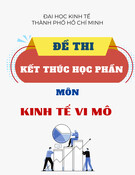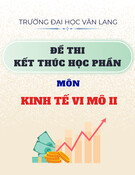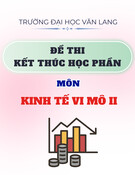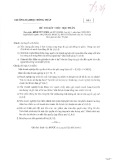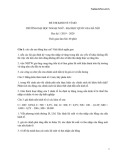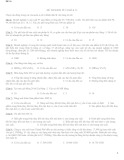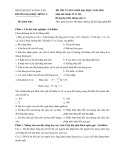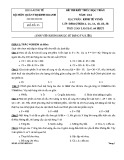
1
FOREIGN TRADE UNIVERSITY
FACULTY OF INTERNATIONAL ECONOMICS
DEPARTMENT OF MICROECONOMICS
MICROECONOMICS
FINAL TEST
Time allowed: 60 minutes
1
2
3
4
5
6
7
8
9
10
11
12
13
14
15
A
B
C
D
16
17
18
19
20
21
22
23
24
25
26
27
28
29
30
A
B
C
D
PART 1: MULTIPLE CHOICE QUESTIONS (6 points)
1. Economics deals primarily with the concepts of
A. Money and banking
B. Poverty and wealth
C. Scarcity and choice
D. Debits and credits
2. Rational people think at
A. The utility
B. The benefit
C. The cost
D. The margin
3. Suppose that demand function of good X is QDx = n.PX + m.PY + k. If X and Y are
subtitutes then
A. n.m = 0
B. n.m > 0
C. n.m < 0
D. Not enough information to conclude
4. Engel curve reflects the relationship between
A. Price and quantity demanded

2
B. Price and quantity supplied
C. Income and quantity demanded
D. Income and quantity supplied
5. If A and B are complementary goods, what will happen to price of good B when price
of good A increases?
A. Price of good B will increase
B. Price of good B will decrease
C. Price of good B will stay the same
D. Cannot conclude about price of good B
6. Which of the following would not shift the demand curve for beef?
A. a widely publicized study that indicates beef increases one's cholesterol
B. a reduction in the price of cattle feed
C. an effective advertising campaign by pork producers
D. a change in the incomes of beef consumers
7. Setting a binding price floor will
A. increase consumer surplus and increase producer surplus
B. increase consumer surplus and decrease producer surplus
C. decrease consumer surplus and decrease producer surplus
D. decrease consumer surplus and increase producer surplus
8. Technological advance in agriculture reduces cost of production. If demand for
agricultural products are inelastic, we can expect that
A. Quantity increases, total revenue increases
B. Quantity increases, total revenue decreases
C. Quantity decreases, total revenue increases
D. Quantity decreases, total revenue decreases
9. In which case does supply curve go through the origin?
A. Perfectly elastic supply
B. Perfectly inelastic supply
C. Relatively inelastic supply
D. Unitary elastic supply
10. The larger the positive cross-price elasticity coefficient of demand between 2 products
X and Y, the
A. stronger their complementariness
B. stronger their competitiveness
C. smaller their complementariness

3
D. smaller their competitiveness
11. If Government levies an excise tax on producers but the market price is unchanged
then we can conclude that demand curve is
A. More elastic than supply curve
B. Less elastic than supply curve
C. Perfectly inelastic
D. Perfectly elastic
12. The shape of a typical indifference curve is
A. L-shaped
B. Linear
C. Hyperbol
D. Concave to the origin
13. All of the following are properties of budget line except
A. Budget lines always linear.
B. Budget lines are downward sloping.
C. When income changes, budget line will shift paralell.
D. Slope of budget line represents the relative price of two goods.
14. Which of the following utility function has constant marginal rate of subtitution?
A. U = min{2X;3Y}
B. U = X.Y
C. U = X0,4Y0,6
D. U = (4X + 3Y)2
15. Given the utility function U = XY with PX = 2$, PY = 4$, I = 160$. Optimal consumption
combination is
A. X = 10, Y = 20
B. X = 20, Y = 10
C. X = 20, Y = 40
D. X = 40, Y = 20
16. The area above marginal cost curve and below marginal revenue curve of firm is
A. Total revenue
B. Producer surplus
C. Total cost
D. Variable cost
17. Implicit costs are
A. equal to total fixed costs.

4
B. comprised entirely of variable costs.
C. payments for self-employed resources.
D. always greater in the short run than in the long run.
18. If total cost curve becomes steeper as quantity output increases then
A. Average fixed cost increases
B. Marginal cost decreases
C. Marginal product of labor decreases
D. Average product of labor decreases
19. When firm A produces 4 units of output, total cost and average variable cost are
$160.000 and $30.000 respectively. If firm A produces 10 units of output then average
fixed cost is
A. $4.000
B. $40.000
C. $120.000
D. $10.000
20. Total cost of firm A when it produces nothing is 200$. When quantity of output equals
to 1 and 2 units, this firm’s total cost are 220$ and 250$ respectively. Marginal cost and
average fixed cost of firm A when it produces 2 units are
A. MC = 30$ and AFC = 200$
B. MC = 250$ and AFC = 200$
C. MC = 30$ and AFC = 100$
D. MC = 250$ and AFC = 100$
21. The decision to select the best supplier in perfectly competitive market is
A. Not necessary
B. Very necessary
C. Necessary in some cases
D. Cannot conclude
22. Perfectly competitive firms can maximize total revenue when
A. Marginal revenue equals to zero
B. Marginal revenue equals to marginal cost
C. Total revenue equals to total cost
D. None of the above are correct
23. If total revenue of a perfectly competitive firm can compensate for its variable cost
and a part of its fixed cost then it is producing at the output level
A. Greater than break-even point

5
B. Less than break-even point
C. Larger than shut-down point
D. Both B and C are correct
24. Which of the following is NOT a characteristic of a perfectly competitive market?
A. The products that each seller produces are identical.
B. There is perfect knowledge regarding the prices and qualities available to consumers.
C. Sellers compete with each other by charging different prices.
D. It is easy for sellers to enter and exit the market in the long run.
25. Economic profit is equal to
A. total revenue minus the explicit cost of producing goods and services.
B. total revenue minus the implicit cost of producing goods and services.
C. accounting profit minus the sunk cost of producing goods and services.
D. accounting profit minus the opportunity cost of producing goods and services.
26. Firm’s demand curve in monopoly market
A. Is downward sloping
B. Is horizontal at the market price
C. Double the slope of marginal revenue curve
D. Both A and C are correct
27. For a nondiscriminating monopolist, which of the following statements is true?
A. The monopolist never incur a loss.
B. The monopolist’s supply curve is a part of marginal cost curve.
C. The monopolist will always produce in the inelastic range of its demand curve.
D. Unlike a firm in perfect competition, a monopolist has AR > MR.
28. Dead-weight loss created by monopolist is the area
A. Above supply curve and below demand curve, restricted from optimal quantity of
monopoly market to optimal quantity of perfectly competitive market.
B. Above marginal cost curve and below demand curve, restricted from optimal quantity
of monopoly market to optimal quantity of perfectly competitive market.
C. Above demand curve and below marginal cost curve, restricted from optimal quantity
of monopoly market to optimal quantity of perfectly competitive market.
D. Above marginal cost curve and marginal revenue curve, restricted from optimal quantity
of monopoly market to optimal quantity of perfectly competitive market.
29. The higher value of Lerner index is, profit of monopolist will be
A. Higher
B. Lower

